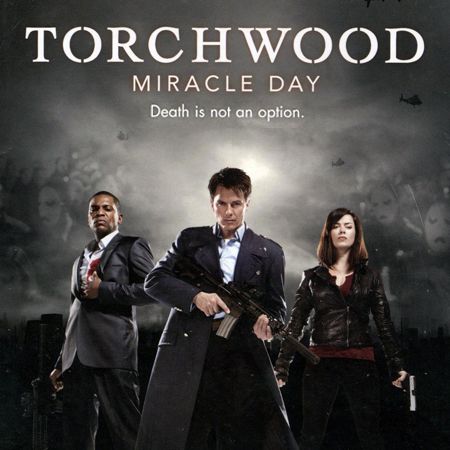
Torchwood: Miracle Day begins tonight
Sept. 14 at 9:00 pm EDT on BBC America
I've not been doing much writing lately... obviously. I'm still settling in after our most recent move. But, on my breaks from unpacking boxes, I've mostly been staring at that other box... the idiot box. It was supposed to be passive, relaxing entertainment -- a restorative after long, hard days of hating the entire process of moving. Instead, I've once again been pulled down a rabbit hole into a network of intertwining symbolism and myth. I pretty quickly noticed that a theme was emerging and that the theme was immortality.
I finally had the opportunity to see Torchwood: Miracle Day when it came on Encore. I'd been wanting to see it since it came out but I don't have or want Starz. The previous Torchwood miniseries Children of Earth was excellent if very, very disturbing. I had wanted to write about some of the symbolism of that series when it aired but after I watched the final episode, I was just too emotionally wrecked and I never wanted to look at the series again. Miracle Day is also very dark. The mythic symbolism is, once again, so veiled, you could easily miss it.
Human immortality is suddenly, inexplicably achieved and the world discovers that it's really very inconvenient. This is not a good version of immortality. It's not an ascension of any kind. It's just an inability to die no matter how sick, old, injured, or executed one might be. But underneath all the gruesome dreariness of that Torchwood sensibility, there are subtle points to some greater themes, which keep this from being pedestrian science fiction of the "wouldn't it be weird if" variety.
As Doctor Who fans know, Jack Harkness's immortality is an aberration -- a fluke that the Doctor finds disturbing and wrong and against the natural order. But there are subtle nods to a deeper mythos. In Children of Earth, for instance, Jack is killed, dismembered and buried in cement, only to be reassembled and resurrected. He has become Osiris. In Miracle Day we again see him playing out a resurrection mythology as he is effectively crucified -- hung by his arms, tormented by townspeople, and put to death, only to rise again... and again and again.
As the plot of Miracle Day unfolds we learn that there is some serious corruption underlying the management of this crisis of undeadness and that this corruption may even point to the architects of the phenomenon. A pharmaceutical company called PhiCorp seems to have the inside track and it's poised to make a killing on deathlessness.

The symbol on PhiCorp's logo is revealed to symbolize a kind of physical, geographically located axis mundi which has been identified by this shadowy group of megalomaniacs and from which much on the planet can be controlled. Unaddressed is that the symbol indicates much more than that. It's the Greek symbol for phi. PhiCorp. Get it? The phi ratio is also known as the Golden Mean, the Divine Proportion, and is sometimes even called God's Equation. It is the most irreconcilable of irrational numbers, stretching out into eternity.
And it is woven repeatedly into the fabric of organic life.
Phi is also laid out graphically in the symbol of the pentacle.
Of all symmetric geometric shapes, none represent so concisely the principles of PHI than the pentacle or five pointed star within a circle. This is probably so because the ratio of PHI is first derived from the square root of five. Using a compass, draw a circle with five points spaced at exactly 72 degree apart with the first point at the top. Connect the points at 144 degree intervals with straight lines. Notice that both numbers 5 and 144 occur in the first twelve terms of the Fibonacci series.
So I found it kind of interesting that the pentacle figured rather prominently in the movie Elysium, which I saw in the theater days after finishing Miracle Day. I wasn't far into the movie before I'd noticed that it was the same storyline. An affluent elite masters life extending technology -- machines that cure any disease or injury in seconds -- as it exploits the rest of the world's population. That elite live on Elysium and Elysium is a giant pentacle... and a circumpunct... for good measure.
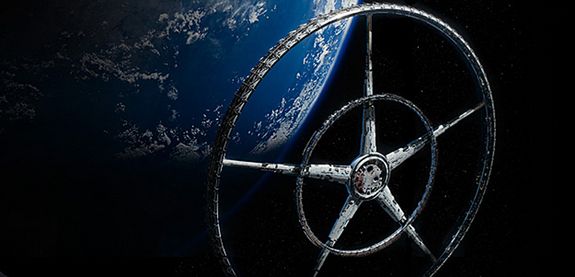
The name Elysium comes from Greek mythology.
The Elysian Fields were, according to Homer, located on the western edge of the Earth by the stream of Okeanos.[1] In the time of the Greek oral poet Hesiod, Elysium would also be known as the Fortunate Isles or the Isles (or Islands) of the Blessed, located in the western ocean at the end of the earth.[1][7][8] The Isles of the Blessed would be reduced to a single island by the Thebean poet Pindar, describing it as having shady parks, with residents indulging their athletic and musical pastimes.[1][2]
Similarly, the afterworld known as the Egyptian Duat or Tuat is also referred to as the beautiful West. It is also symbolized by a star in a circle.

My journey into circumpuncts and immortality deepened when I stumbled into the cult hit Pushing Daisies, which I'd only ever caught in bits and pieces before. I can't believe I was missing this show. It's amazingly brilliant -- brilliantly acted, brilliantly written, brilliantly designed. The improbable narrative involves a man who has known since childhood that he can bring the dead back to life with a single touch. A second touch and they are dead forever. It is also drenched in visual symbolism of the alchemical variety. Were it not a candy-colored, hyper-real, fairy tale of a show the endless repetition of sacred symbols might seem heavy handed. Instead, it's just luscious.
Central to this show about a man with a gift for raising the dead is an endless stream of circles and circumpuncts. Ned is first and foremost a maker of very circular pies.
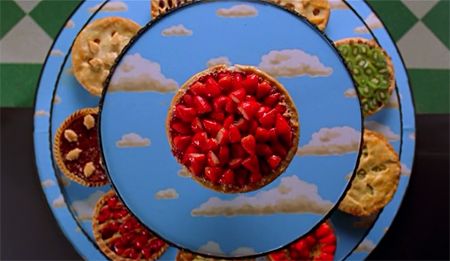
Ned owns a charming eatery called The Pie Hole, "as in shut your..." But the name could also be read as a pie with a hole in the center forming a circumpunct. The geometric patterns on his pies vary but at least some of them are circumpuncts. In a scene set in his boarding school, a young Ned makes pies for the other children, and all of them are circumpuncts.

As the boys devour the pies in a spontaneous late night celebration, the camera moves from pies and pie holes to the wormhole of one child's saxaphone.
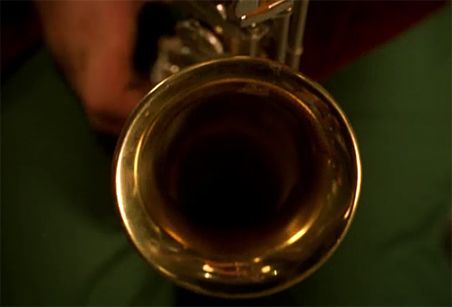
In another boarding school vignette, Ned plays with marbles in a circumpunct with a border that looks an awful lot like pie crust.

But a marble bounces out of the circle and hits the glass cases freeing a python and a rabbit resulting in the obvious. It would be difficult to miss the kundalini symbolism.
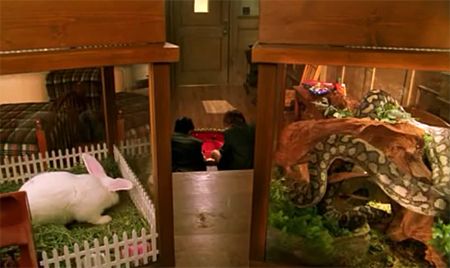
The serpenty imagery also expresses subtly through the aunts of Ned's childhood sweetheart Chuck (Charlotte Charles) whom he has also resurrected after her murder. Lily (divinity and immortality) and Vivian (alive) Charles were the Darling Mermaid Darlings. Mermaids are connected to serpent and kundalini mythology. Note the resemblance to double-tailed images of Melusine and the stargate opening up behind them.
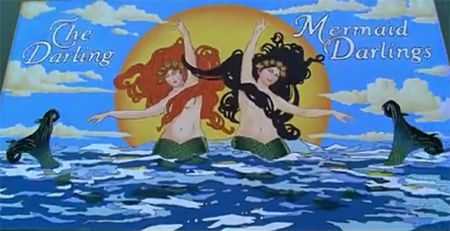
The aunts' house like every other location is a study in circular portals.
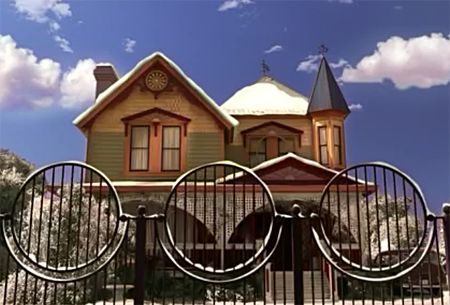
Even the windows are marvelous replicas of one of Ned's circumpunct pies cut into neat slices.
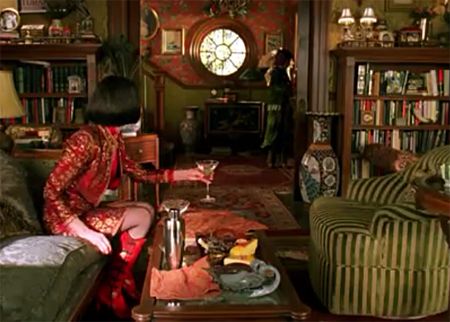
The aunts also have an affinity for keeping the dead lifelike with the bizarre funerary rite of taxidermy -- birds, mostly. This includes a prominently placed peacock. Again, this tableau would be downright heavy-handed if it weren't a perfectly dressed set, overwhelming the senses with Victorian-style clutter. Vivian is wearing lilies. Lily is wearing circumpuncts on her sweater, her flower necklace, and her eye patch. ("If thine eye be single..")
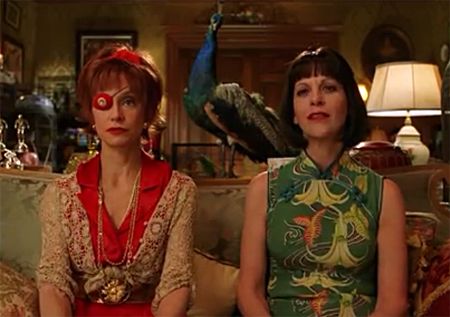
The peacock also represents the activated pineal gland with its tail full of open eyes. This classic symbolism is on vivid display in, of all places, the Vatican's Pine Cone Court.
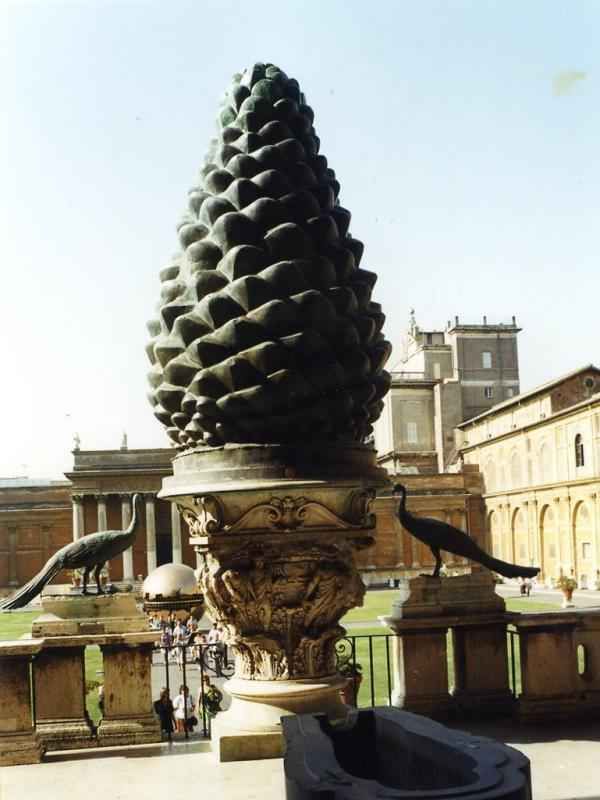
I may be mistaken but it looks to me like every detail of Pushing Daisies is thought about and brilliantly executed to reinforce the idea of alchemical transformation and transcendence of death.
Even the tertiary character of Olive represents immortality. The olive tree is an evergreen and for all intents and purposes immortal. Thus did Jesus Christ ascend into heaven from the Mount of Olives.
The heavens themselves are graphically depicted over and over again with brilliant blue and fluffy, white clouds. For me it brings to mind the "Apotheosis of George Washington" in the Capitol dome.
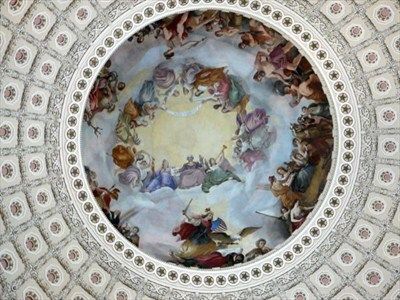
If the circumpunct imagery here:
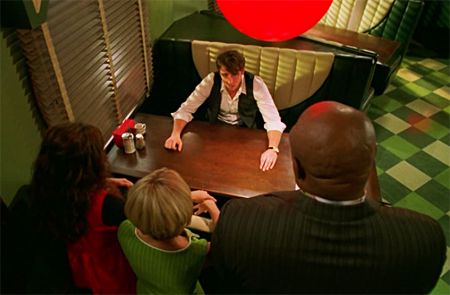
There:
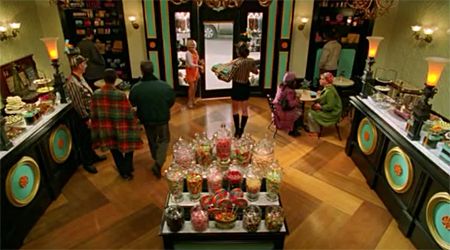
And everywhere:
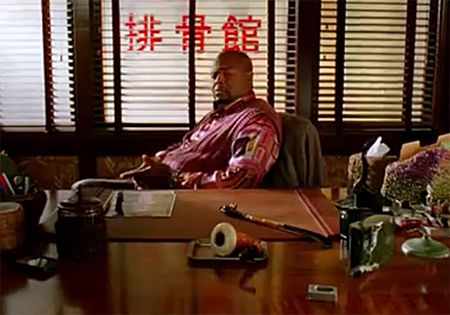
Fails to convince you that this is an alchemical story of union and resurrection, bear in mind that one of the uses of that symbol is gold -- like the gold our young lovers find inside the ceramic (mud) monkeys (less evolved humans) that Chuck unwittingly died for.
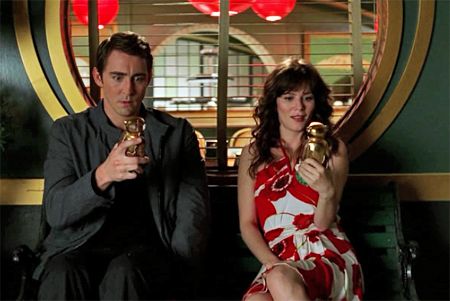
From the sublime and prematurely canceled Pushing Daisies, I moved on to the somewhat ridiculous Netflix series Hemlock Grove. Panned by critics and all but buried on the Netflix site, I found it kind of by accident. And I love it. Well, to be fair, I love/hate it because it's so incredibly bad/good.
I guess it should come as no surprise that a Twilightesque show about werewolves and other supernatural creatures would raise the specter of immortality. Hemlock Grove looks, on the surface, like a thoroughly predictable teen-targeted horror romance. But it throws a few curve balls and makes itself far more interesting than one might expect. For starters, the show's vampire themes pull from different lore. These are upyrs. They go about easily in sunlight, they have children the normal way, and they crave not only blood but raw flesh.
The primary upyr, played by the inimitable Famke Janssen, is called Olivia. (olive tree) So right off we have a clue to her immortality even though it is not immediately apparent that she's an upyr. In fact this is a bit of a spoiler because we don't know for sure what she is until the season finale. We do get that she's not quite human and horribly creepy from the first episode.
Janssen has taken a real pasting from critics and viewers alike for her dialect work. It's a simply horrible British accent. But I'm not sure people are giving her enough credit. I've heard her do some really subtle, beautiful dialect work in the past. She's not American. She's Dutch. And she speaks multiple languages. I think her atrocious dialect is an acting choice and is another clue to Olivia's bizarre and hidden history. She's merely posing as British to hide her long, convoluted life story and the accent sounds exactly as phony and pretentious as she is. It is also a conglomeration of dialects she's picked up through her many, many years. The result is a weird mix of badly meshing and not well concealed dialectical history. In fairness to her critics, though, it's bad enough to be distracting.
What struck me, though, was the very subtle allusions to the Melusine myth. It's about the only thing in the show that is subtle which makes it even more interesting. Olivia is Melusine. It's revealed in the little details, like her appearance in a mermaid gown, complete with what looks like seaweed clinging to her shoulders
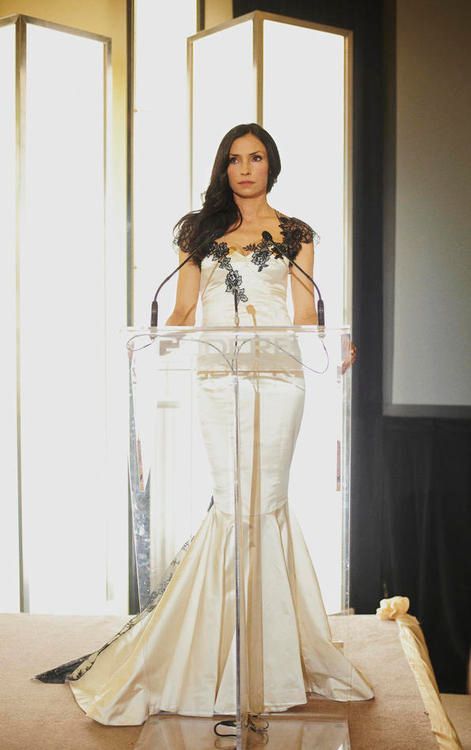
One of her children is extremely deformed and the other isn't quite right either, although he's physically handsome.
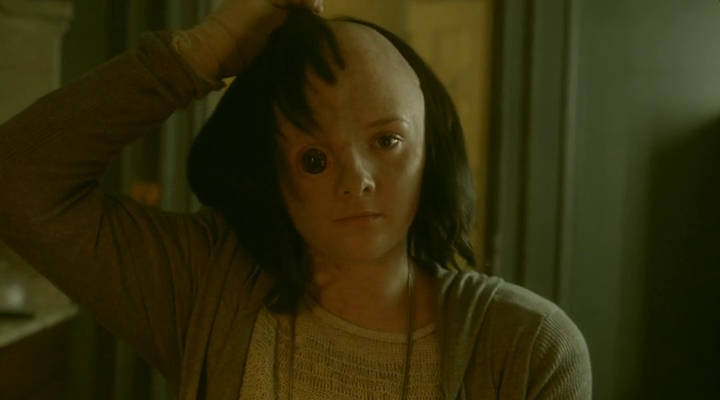
She has an affinity for marrying and building family wealth. There is an air of royalty about her. And she is associated with the building of a great tower. The so called White Tower imposes itself on the entire little town.
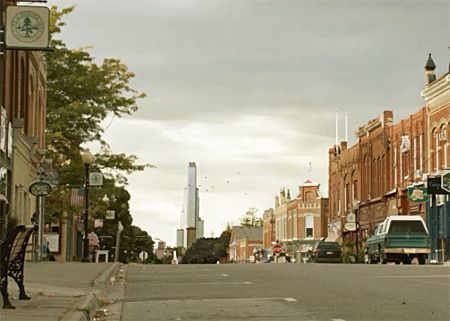
When we finally learn her origin story, we find that she was born with a vestigial tail, since removed. Immediately after this flashback scene we see her in a gown with a tail-like train.
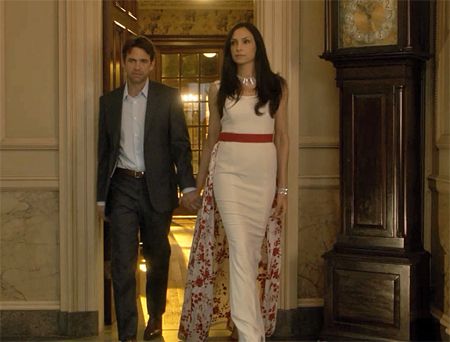
There are multiple references to dragons. At one point she tells her son Roman that he is a dragon, one assumes by inheritance. Unbeknownst to him he has been making nocturnal journeys on wings.
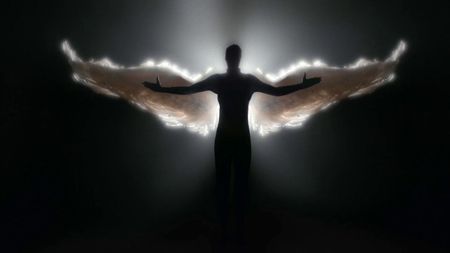
All of this seems to very deliberately point to Melusine lore, which, itself, combines elements of mermaid, siren, and dragon mythology. Melusine is a serpent goddess. She builds towers which means she raises kundalini up the spine. And deep in the White Tower is a project called ouroboros. And the ouroboros is popping up everyhwere in people's dreams, waking visions, and cheap trinkets.
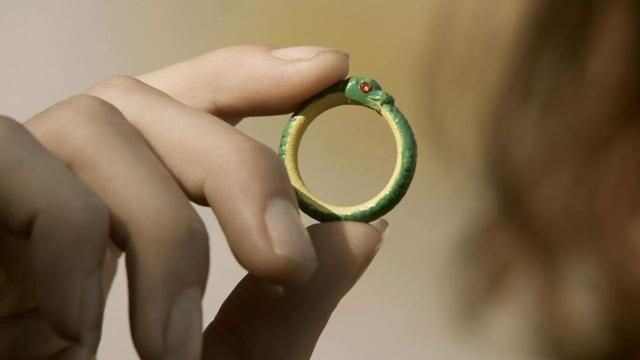
The slightly mad scientist who is developing the ouroboros project is experimenting with life itself and apparently raised our poor, deformed Shelley from the dead. The name is an obvious allusion to Mary Shelley's Frankenstein. She's about 7 feet tall with mismatched parts and mummy wraps on her hands so it's kind of hard to miss. But she's very sweet and smart and gives off an iridescent glow when she's happy. Like her literary forebear she's a tragic character and the result of arrogantly playing in God's domain.
That said Hemlock Grove hints again at alchemical and kundalini mythology as it reveals the mythological mystery behind Olivia's secret identity.
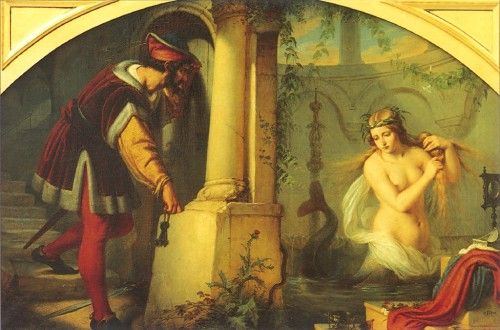
I also watched The Secret of Kells when I was having trouble sleeping one night. This is not so much about immortality but it is filled with blatant kundalini mythology and the rich fairy lore of Ireland that merged with Christianity in works like, well, the Book of Kells.
The movie doesn't skimp on third eye imagery starting right off with goose quills that look an awful lot like peacock feathers.
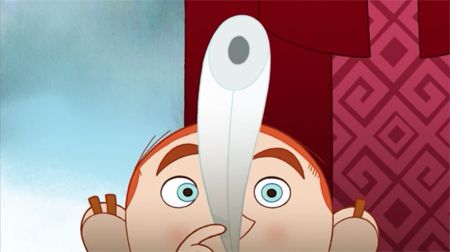
It openly states that the visionary monk who began the great work of illuminated manuscript at Iona had a third eye.
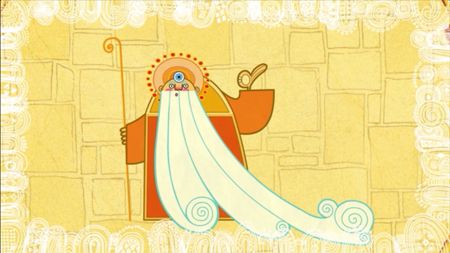
That third eye -- the Eye of Collum-Cille -- was won from the monster Crom Cruach. But when the greatest living illuminator Aiden of Iona comes to Kells to escape the advancing Norsemen he finds that the eye has been lost and loses all hope of completing the manuscript.
But our hero, young Brendan, has had a vision of the eye while wandering in the forest looking for ink berries. He'd gotten too close to one of the dwelling places of Crom Cruach.

Brendan sets out to do battle with Crom Cruach and win another eye so that he and his new mentor can finish the book. This he does and it would be hard to miss the imagery. He goes deep into the earth to wrestle with a giant serpent that then devours itself like an ouroboros as he gains a new third eye.
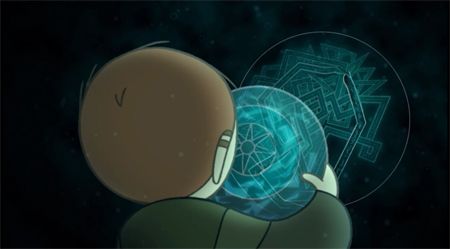
The story is deeply supernatural and overtly Pagan as the young monk is aided by a forest sprite of some kind and a shapeshifting cat.
It is also replete with more circumpunct imagery than could be easily catalogued. It's in nearly every frame but I thought the circumpunct labyrinth with the obelisk-like tower in the middle was particularly interesting.
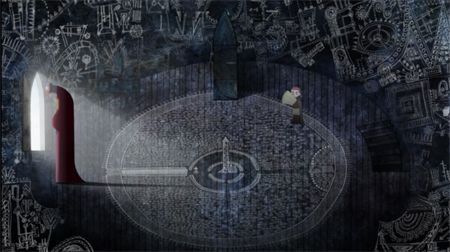
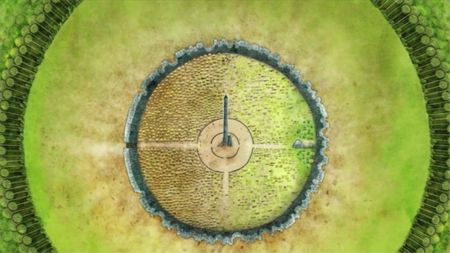
I found it even more interesting when I saw this little oddity in the news the next day.
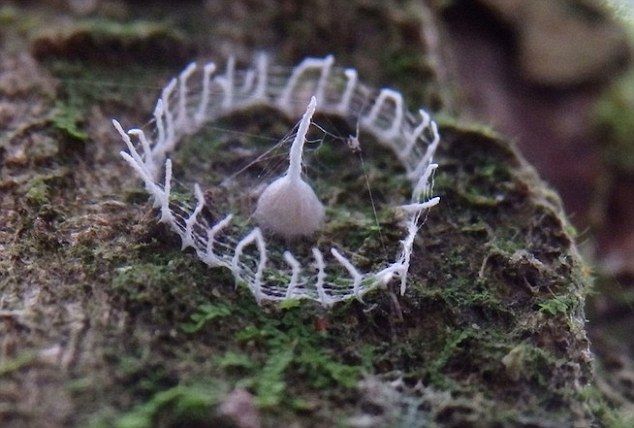
No one seems to know what this little "mystery tower" is.
A mysterious structure which has appeared in the Peruvian Amazon - and appears to be a spire surrounded by a white picket fence - is baffling scientists.
The first of the structures was spotted just months ago on June 7, by Troy Alexander, a graduate student at Georgia Tech.
He discovered the bizarre formation on the bottom of some blue tarpaulin close to the Tambopata Research Center, in southeastern Peru.
Comments on this entry are closed, on this blog. If you wish to comment, please find this and all newer blog entries crossposted on Celestial Reflections.

